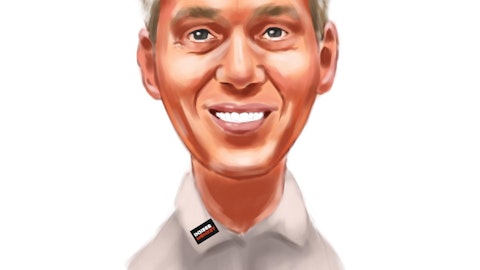John Rowan: Okay, and then I’m just trying to — you talked about better originations. I mean, next quarter, does the loan portfolio go up or down from where it is today?
Chad Prashad: Typically in the fourth quarter, we have a fair amount of runoff, and that’s primarily driven to tax season and tax refunds. I don’t think we have any expectation that this fourth quarter will be any different than prior fourth quarters in terms of runoff. And also the fourth quarter is not typically a quarter of a large investment in new customers. So I wouldn’t expect us to grow at a higher rate in the fourth quarter this year than we have in any prior year.
John Rowan: And then last question for me, where do you stand on your covenants, the waivers, and when would you potentially be refinancing your revolving credit facility? Thank you.
John Calmes: Sure, yes. So we amended the credit facility in — during the quarter, and we have plenty of room on all the covenants and there are no waivers as of the quarter end. And so we will look to extend that facility in this coming summer.
John Rowan: If I’m not mistaken, John, it was around June, you used to do it every year, correct?
John Calmes: That’s right. Yes.
John Rowan: Okay, all right. That’s it for me. Thank you.
John Calmes: Thank you.
Operator: Thank you. Next question comes from Vince Caintic with Stephens. Please go ahead.
Vince Caintic: Hey, thanks so much. Thanks for taking my question. Just a quick follow-up from John Rowan’s questions. So it is encouraging to see that the first-pay defaults are improving. I’m just kind of wondering, all else being equal, if you can kind of play out how you think that’s going to roll into delinquencies and losses because just the 25% is high, but are we now — should we expect kind of going back to historical levels and sort of what’s the cadence to get there? Thank you.
John Calmes: Sure. Yes. So as you can see, the front-end delinquency as of December is much lower than it was in September and as well as it historically is at December, right? So medium term, that looks like — it indicates that charge-offs start to come down. At December, the 90-day delinquency bucket is still relatively high, but it did come down from September. I think in dollars, it came down around $4 million, $5 million since September. And we expect that to continue to come down during Q4. At this point, during January, the 90-day bucket has already come down close to $6 million from December. And that’s with charge-offs for January look to be lower than they were in December. And kind of looking forward, you can tell that February charge-offs should be lower than January and March should be lower than February, right?
So all the trends look very positive. So we believe by the time we get to March, the delinquency picture should look pretty good and lead to lower charge-offs from that point. But that being said, but we do expect elevated charge-offs in Q4 relative to historicals. But they should be better from a growth standpoint compared to Q3.
Vince Caintic: Okay. That’s very helpful. Thank you. And helpful January data, I really appreciate that. The ADQs that came down $6 million. And then I guess in terms of the credit reserves, is the level that we see today anticipating those declines? Or should we be expecting further reductions in credit reserve allowances?
John Calmes: No. So we haven’t forecasted the declines that happened in January explicitly in the allowance, right? So a lot of that will be baked in, but there’s nothing sort of additional — no additional reductions for what we’re seeing today.




